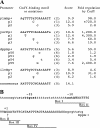Genetic and biochemical analysis of CodY-binding sites in Bacillus subtilis
- PMID: 18083814
- PMCID: PMC2238193
- DOI: 10.1128/JB.01780-07
Genetic and biochemical analysis of CodY-binding sites in Bacillus subtilis
Abstract
CodY is a global transcriptional regulator that is known to control directly the expression of at least two dozen operons in Bacillus subtilis, but the rules that govern the binding of CodY to its target DNA have been unclear. Using DNase I footprinting experiments, we identified CodY-binding sites upstream of the B. subtilis ylmA and yurP genes. The protected regions overlapped versions of a previously proposed CodY-binding consensus motif, AATTTTCWGAAAATT. Multiple single mutations were introduced into the CodY-binding sites of the ylmA, yurP, dppA, and ilvB genes. The mutations affected both the affinity of CodY for its binding sites in vitro and the expression in vivo of lacZ fusions that carry these mutations in their promoter regions. Our results show that versions of the AATTTTCWGAAAATT motif, first identified for Lactococcus lactis CodY, with up to five mismatches play an important role in the interaction of B. subtilis CodY with DNA.
Figures






Similar articles
-
Activation of the Bacillus subtilis global regulator CodY by direct interaction with branched-chain amino acids.Mol Microbiol. 2004 Jul;53(2):599-611. doi: 10.1111/j.1365-2958.2004.04135.x. Mol Microbiol. 2004. PMID: 15228537
-
Roadblock repression of transcription by Bacillus subtilis CodY.J Mol Biol. 2011 Aug 26;411(4):729-43. doi: 10.1016/j.jmb.2011.06.012. Epub 2011 Jun 15. J Mol Biol. 2011. PMID: 21699902 Free PMC article.
-
CodY-mediated regulation of guanosine uptake in Bacillus subtilis.J Bacteriol. 2011 Nov;193(22):6276-87. doi: 10.1128/JB.05899-11. Epub 2011 Sep 16. J Bacteriol. 2011. PMID: 21926227 Free PMC article.
-
CodY is a nutritional repressor of flagellar gene expression in Bacillus subtilis.J Bacteriol. 2003 May;185(10):3118-26. doi: 10.1128/JB.185.10.3118-3126.2003. J Bacteriol. 2003. PMID: 12730172 Free PMC article.
-
CodY, a master integrator of metabolism and virulence in Gram-positive bacteria.Curr Genet. 2017 Jun;63(3):417-425. doi: 10.1007/s00294-016-0656-5. Epub 2016 Oct 15. Curr Genet. 2017. PMID: 27744611 Review.
Cited by
-
Physiological adaptation of Desulfitobacterium hafniense strain TCE1 to tetrachloroethene respiration.Appl Environ Microbiol. 2011 Jun;77(11):3853-9. doi: 10.1128/AEM.02471-10. Epub 2011 Apr 8. Appl Environ Microbiol. 2011. PMID: 21478312 Free PMC article.
-
Role of PdxR in the activation of vitamin B6 biosynthesis in Listeria monocytogenes.Mol Microbiol. 2014 Jun;92(5):1113-28. doi: 10.1111/mmi.12618. Epub 2014 May 5. Mol Microbiol. 2014. PMID: 24730374 Free PMC article.
-
Genetic and Biochemical Analysis of CodY-Mediated Cell Aggregation in Staphylococcus aureus Reveals an Interaction between Extracellular DNA and Polysaccharide in the Extracellular Matrix.J Bacteriol. 2020 Mar 26;202(8):e00593-19. doi: 10.1128/JB.00593-19. Print 2020 Mar 26. J Bacteriol. 2020. PMID: 32015143 Free PMC article.
-
CodY-mediated regulation of the Staphylococcus aureus Agr system integrates nutritional and population density signals.J Bacteriol. 2014 Mar;196(6):1184-96. doi: 10.1128/JB.00128-13. Epub 2014 Jan 3. J Bacteriol. 2014. PMID: 24391052 Free PMC article.
-
Impact of growth pH and glucose concentrations on the CodY regulatory network in Streptococcus salivarius.BMC Genomics. 2018 May 23;19(1):386. doi: 10.1186/s12864-018-4781-z. BMC Genomics. 2018. PMID: 29792173 Free PMC article.
References
-
- Belitsky, B. R., and A. L. Sonenshein. 2002. GabR, a member of a novel protein family, regulates utilization of γ-aminobutyrate in Bacillus subtilis. Mol. Microbiol. 45569-583. - PubMed
Publication types
MeSH terms
Substances
Grants and funding
LinkOut - more resources
Full Text Sources
Molecular Biology Databases

